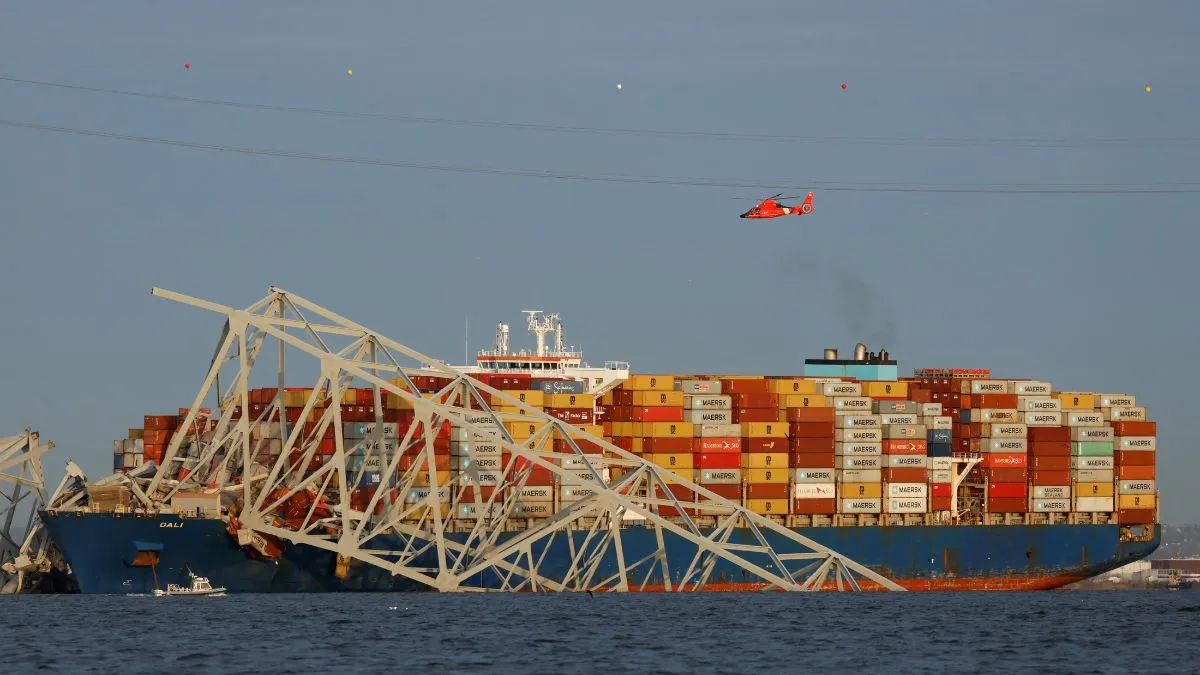Baltimore: A cargo ship rammed into Baltimore’s Francis Scott Bridge early Tuesday, causing the span to collapse and the presumed deaths of six people.
Here’s what we know so far about the disaster:
WHAT EXACTLY HAPPENED?
The operators of the Dali cargo ship issued a mayday call that the vessel had lost power moments before the crash, but the ship still headed toward the span at “a very, very rapid speed,” Maryland Gov. Wes Moore said.
The 985-foot-long (300-meter-long) vessel struck one of the 1.6-mile (2.6-kilometer) bridge’s supports, causing the span to break and fall into the water within seconds.
Six construction workers who were filling potholes on the bridge were still missing Tuesday afternoon and presumed dead. Jeffrey Pritzker, executive vice president of Brawner Builders, said they were working in the middle of the span when it came apart.
VIDEO: Drone view of Baltimore bridge collapse
An inspection of the Dali last June at a port in Chile identified a problem with the ship’s “propulsion and auxiliary machinery,” according to Equasis, a shipping information system. The deficiency involved gauges and thermometers, but the website’s online records didn’t elaborate.
The most recent inspection listed for the Dali was conducted by the U.S. Coast Guard in New York in September. The “standard examination” didn’t identify any deficiencies, according to the Equasis data.
The ship was moving at 8 knots, which is roughly 9 mph (15 kph). Given the vessel’s massive weight, it struck the bridge support with significant force, said Roberto Leon, a Virginia Tech engineering professor. “The only way the post can resist it is by bending,” Leon said. “But it cannot absorb anywhere near the energy that this humongous ship is bringing. So it’s going to break.”
Last June, federal inspectors rated the 47-year-old bridge in fair condition. But the structure did not appear to have pier protection to withstand the crash, experts said. “If a bridge pier without adequate protection is hit by a ship of this size, there is very little that the bridge could do,” Leon said.
HOW MANY PEOPLE ARE MISSING?
Two people were rescued, but officials said six people were still unaccounted for as of late morning. All were believed to be part of a construction crew that was repairing potholes on the bridge.
Multiple vehicles also fell into the water, although authorities don’t think anyone was inside them.
The ship is owned by Singapore-based Grace Ocean Private Ltd., which said all crew members, including the two pilots, were accounted for and there were no reports of injuries.
The ship’s warning enabled authorities to limit vehicle traffic on the span. Plus, the accident occurred at 1:30 a.m., long before the busy morning rush. The bridge carried an estimated 30,800 vehicles a day on average in 2019.
WHAT IMPACT COULD THIS HAVE?
The collapse will almost surely create a logistical nightmare for months, if not years, in the region, shutting down ship traffic at the Port of Baltimore, a major shipping hub. The accident will also snarl cargo and commuter traffic.
The port is a major East Coast hub for shipping. The bridge spans the Patapsco River, which massive cargo ships use to reach the Chesapeake Bay and then the Atlantic Ocean.
The Dali was headed from Baltimore to Colombo, Sri Lanka, and flying under a Singapore flag, according to data from Marine Traffic.
President Joe Biden said Tuesday that he plans to travel to Baltimore “as quickly as I can” and that he expects the federal government to pick up the entire cost of rebuilding the bridge.
The collapse, however, is not likely to have a big effect on worldwide trade because Baltimore is not a major port for container vessels, but the port’s facilities are more important when it comes to goods such as farm equipment and autos, said Judah Levine, head of research for global freight booking platform Freightos.
Leon, the Virginia Tech professor, said lessons can be learned and improvements can be made following this disaster. For example, bridge cameras and sensors can be used to track when a cargo ship heads off course and communicate with traffic lights and gates at bridge entrances.
“I think that our mission now is to learn from this failure and learn at all levels,” Leon said.
HOW OFTEN DOES THIS HAPPEN?
From 1960 to 2015, there were 35 major bridge collapses worldwide due to ship or barge collisions, with a total of 342 people killed, according to a 2018 report from the World Association for Waterborne Transport Infrastructure.
Eighteen of those collapses happened in the United States.
Among them was a 2002 incident in which a barge struck the Interstate 40 bridge over the Arkansas River at Webbers Falls, Oklahoma, sending vehicles plunging into the water. Fourteen people died and 11 were injured.
In 2001, a tugboat and barge struck the Queen Isabella Causeway in Port Isabel, Texas, causing a section of the bridge to tumble 80 feet (24 meters) into the bay below. Eight people were killed.
(With inputs from agency)
Also Read: Baltimore Key Bridge collapse: Mass casualties feared as 20 missing after cars plunge into river

